Why Your Scalp Gets Oily Just a Day After Washing: Causes & Solutions
- A Day Later, Greasy Again? You’re Not by Yourself
- Your scalp feels oily again in the morning after washing your hair yesterday? It’s annoying, but for many people, it’s typical.
- You might be surprised to learn how frequent this experience is.
- Oily Scalp Solutions Many people suffer from the never-ending cycle of wash, grease, repeat, especially those with oily or combo hair types.
- You’re not alone if you’re wondering why, even after shampooing, your scalp gets greasy so soon.
- You’re not doing anything “wrong.” In actuality, your scalp and hair have certain requirements, and there may be a number of underlying factors at play here.
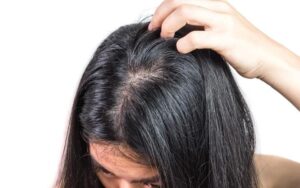
- A mismatch between your scalp type and the items you’re using may also be the cause of greasy hair after just one day.
- Heavy conditioning chemicals found in many shampoos marketed as “moisturising” or “for damaged hair” may be too rich for a person with an oily scalp.
- On the other hand, the scalp may overcompensate by creating more sebum if very harsh, sulfate-containing shampoos are used to remove its natural oils.
- It’s a delicate balance that calls for awareness, attentiveness, and the proper regimen of care.
- Lifestyle is another often-ignored cause. Through hormonal routes, stress, a poor diet, dehydration, and sleep deprivation can all cause excessive oil production.
- Additionally, buildup that makes hair appear greasier than it actually is can be caused by touching your hair a lot, using dirty combs or pillows, or applying styling products too close to the roots.
- The purpose of this blog is to assist you in ending the cycle.
- Supported by professional knowledge, scientific justifications, and workable solutions, we’ll examine the true causes of your scalp’s rapid oiliness and provide tailored methods to restore equilibrium without the need for harsh treatments or excessive washing.
- We will also assist you in comprehending:
- The science behind sebum and the reasons it’s not always harmful
- How to pick products based on the kind of your scalp
- Daily routines that could be destroying the freshness of your hair
- Professional advice and natural solutions to gradually lower oil production
2. Understanding Your Scalp’s Natural Oil: Sebum
- Why Is Sebum Important and What Is It?
- Sebum is frequently misinterpreted. Sebum is actually essential to the health of your scalp and hair, despite the fact that many people mistake it for being oily, acne-prone, or dirty.
- The waxy, greasy material known as sebum, which is produced by the sebaceous glands close to the base of hair follicles, has moisturising and protecting properties.
- You may drastically alter the way you take care of your scalp by learning what sebum does and how it can both benefit and harm your hair.
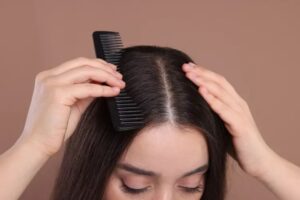
- Lipids, triglycerides, fatty acids, squalene, and wax esters make up sebum. Together, these elements provide natural antibacterial and antifungal protection, preserve the skin barrier, and keep the scalp moisturised.
- Actually, this natural oil is essential to the health of your scalp. Your scalp’s skin would become flaky and dry without sebum, making it more susceptible to infection or irritation.
- Sebum is the natural conditioner of your scalp, according to renowned doctors. Sebum is necessary for shielding the hair shaft, avoiding breakage, and preserving lustre, according to board-certified dermatologist and hair specialist Dr. Francesca Fusco. It only becomes an issue when the equilibrium is thrown off.
- Although sebum is essential, excessive production, particularly close to the roots, can quickly result in greasy, limp, and lifeless-looking hair. Genetics is often the cause of this imbalance. Your scalp most likely overproduces sebum if you have a family history of oily skin.
- Hormones are also very important. Your body may produce more sebum during adolescence, menstruation, pregnancy, or while you’re coping with hormonal imbalances or illnesses like PCOS. Sebaceous glands may go into overdrive due to androgens, the hormones that control oil glands.
- Environmental elements that can increase oil production include heat, humidity, and pollution. Similarly, excessive touching of the scalp, product accumulation, or improper shampoo or conditioner rinse can retain sebum, causing your scalp to feel greasy more quickly than it should.
- The goal is to achieve sebum equilibrium. Your hair stays manageable and shielded from environmental stressors like UV radiation and dry air thanks to a healthy level of sebum, which gives the hair shaft its natural shine and strength.
- Your hair may become brittle and your scalp irritated if you don’t produce enough sebum. If you have too much, you may have to wash your hair more frequently, fight hairline outbreaks, or suffer with dandruff brought on by yeast that feeds on too much oil.
- The most important lesson? Sebum is necessary and not harmful. However, excessive production of it by your scalp indicates that your body is responding to either internal or external stimuli.
- It’s preferable to choose a targeted strategy that supports the natural rhythm of your scalp rather than attempting to remove all of the oil.
3. Common Reasons Your Scalp Gets Oily So Quickly
- If your scalp feels greasy just a day after washing, you’re probably wondering: “Am I doing something wrong?”
- The answer lies not in a single cause, but in a mix of factors—ranging from product choices to internal body changes. Let’s break down the most common reasons behind quick oil buildup.
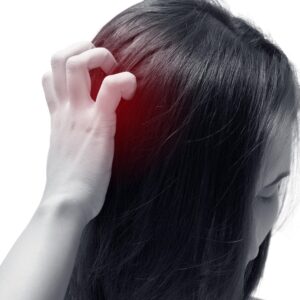
- 3.1. Excessive Hair Washing
- Contrary to popular belief, shampooing your hair too frequently can actually make it oilier. The reason is because in order to stay hydrated and protected, your scalp is made to create a specific quantity of oil, or sebum.
- Daily shampooing removes this natural barrier, especially when using harsh detergents.
- Your sebaceous glands try to make up for the missing oil by going into overdrive. Your scalp produces oil more aggressively the more often you wash, trapping you in a frustrating cycle.
- Unless you’re sweating a lot or using a lot of style products, experts advise washing oily hair no more than two or three times each week.
- Consider using a gentle, balancing shampoo in place of washing every day, and use dry shampoo sparingly in between washes.
- 3.2. Applying the Incorrect Shampoo
- The way your scalp acts after a wash is greatly influenced by your shampoo. Unknowingly, a lot of people use products that are either too rich or too harsh for their particular type of scalp.
- Shampoos with sulphates (typically marketed as “deep cleansing” or “clarifying”) can remove debris and healthy oils, which triggers the production of more sebum by the oil glands.
- However, shampoos designed for dry or damaged hair that are heavy, creamy, or moisturising can leave a residue that, within hours, makes an oily scalp feel greasy.
- Finding a shampoo that cleanses the scalp gently without drying it out or leaving it coated is the aim. Look for labels that state “scalp care,” “balancing,” or similar terms.
- 3.3. Unbalanced Hormones
- The amount of oil your scalp produces is mostly determined by hormones, especially androgens. Hormone levels fluctuate during specific life phases, such as puberty, menstruation, pregnancy, or disorders like PCOS (Polycystic Ovary Syndrome), which can cause overactive sebaceous glands.
- Hormonal changes that cause oiliness are particularly common in women throughout their reproductive years and teenagers. As hormone levels rise during the first trimester of pregnancy or just before your period, you may see greasier hair.
- Seeking advice from a dermatologist or endocrinologist is advised when persistent oiliness is linked to symptoms such as acne, hair loss, or irregular periods. They can assist in determining whether thyroid abnormalities or other underlying hormonal disorders, such PCOS, are at issue.
- 3.4. Unclean pillowcases or hairbrushes
- Despite their apparent innocuousness, your pillowcase and hairbrush may be covert conduits for perspiration, oil, grime, and product residue. In addition to detangling, each time you brush your hair, you may also be reapplying previous bristle remnants and spreading sebum and buildup from your scalp throughout your hair.
- Hairbrushes gather:
- Dead cells in the skin
- Your scalp’s oil
- Remaining product (conditioners, sprays, and serums)
- Lint and dust
- These instruments become a source of infection if they are not cleaned. Hair that has just been washed may look oily much sooner than it should since each brush stroke has the potential to re-deposit old oil onto it.
- For pillowcases, the same reasoning holds true. Your pillow fabric absorbs the oil, perspiration, and product accumulation that your scalp sheds during sleep. You can be rubbing your clean scalp against old dirt every night if you don’t wash or replace your pillowcases every three to four days.
- Pro Tip: To clean your brush, remove any loose hair and bathe it in warm water with baking soda or mild shampoo once a week. To lessen oil transfer, change your pillowcases every week and choose natural, breathable materials like bamboo or cotton.
- 3.5. Excessive Hair Brushing or Touching
- We all do it: brush our hair multiple times a day or idly run our fingers over it in an attempt to keep it looking sleek and put together. However, every time you touch your hair, natural oils are transferred straight from your fingertips to your roots and scalp.
- Furthermore, brushing frequently stimulates the scalp, which may lead to increased production of sebum. Brushing too much might over-activate your oil glands, especially if you already have an oily scalp type, even if a daily detangle is essential for circulation and hair health.
- 3.6. Humidity and Climate
- You’re not dreaming if your scalp feels greasier in the heat or monsoon. Sebum production can be increased by hot and muggy weather, which speeds up the accumulation of oil on the scalp. When combined with natural scalp oils, moist air causes sweating and pore dilatation, which makes your roots feel oily.
- Another factor that leads to product deterioration is humidity. In hot temperatures, styling gels, heat-protectants, and leave-in conditioners may melt or settle unevenly, drawing grime and adhering to the scalp. The outcome? hair that looks greasy after a few hours, regardless of how recently it was washed.
- How should I proceed? During hot or muggy months, switch to water-based, lightweight solutions. To keep the scalp feeling clean, use cleansing products like apple cider vinegar or tea tree oil.
4. Is It Oily Scalp or Product Buildup?
- Ways to Recognise the Difference
- Your oil glands are not always the only cause of greasy roots or a heavy-feeling scalp when you wake up. Sometimes, what you’re feeling is product buildup rather than oiliness from natural sebum.
- If you want to effectively treat your scalp and end the cycle of over-washing or over-treating, it is imperative that you comprehend the difference.
- Let’s examine how to distinguish between oiliness caused by sebum and styling product residue, as well as what to do about each.
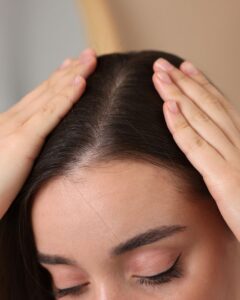
- Comprehending Oiliness Based on Sebum
- Sebum is the natural oil that your scalp produces to keep your skin and hair hydrated and safe, as was previously mentioned. When sebum causes your scalp to get greasy, you’ll usually notice:
- An oily, glossy look close to the roots, especially around the crown and hairline
- Only the roots of your hair become greasy; the rest of your hair may still seem clean or fluffy.
- When you run your fingers through the strands, there is only a slick or oily texture rather than any residue or stickiness.
- After washing, the oiliness usually goes away in 12 to 24 hours, especially in warm weather.
- This type of oiliness typically feels “natural,” not sticky, and frequently has no smell. Hormones, excessive washing, and environmental elements like humidity are frequently implicated.
- Identifying Product Accumulation
- Conversely, product buildup occurs when styling products, such as oils, gels, dry shampoos, serums, sprays, and even thick conditioners, aren’t thoroughly washed or build up over time. Its product accumulation will be seen if:
- Instead of feeling oily, your scalp or hair feel waxy, coated, or heavy.
- White or yellowish residue may be visible, particularly if you use your nails to scratch your scalp.
- Your hair may feel sticky or clump together, and your roots may seem matte or lifeless rather than glossy.
- Even after washing, the problem still exists, particularly if you don’t occasionally use a clarifying shampoo.
- Additionally, accumulation may result in clogged follicles, flaking, inflammation, and itching. In contrast to sebum, which your body naturally controls, product accumulation gets worse over time if it is not adequately eliminated.
- Methods for Testing It: Fast Techniques
- Test of Scalp Rub: Touch your scalp with your fingertips. It is probably oil if it feels smooth and natural. It’s most likely residue if your fingers have a sticky, gritty, or waxy sensation when you remove them.
- Clarifying Wash Test:Try using a clarifying shampoo without sulphates once a week as part of the Clarifying Wash Test. It was buildup if your hair seems lighter and cleaner all of a sudden and stays that way for a longer period of time.
- Water Test: Because of the coating on the strands, hair with product buildup may repel water or take longer to get completely wet in the shower.
- The Significance of It
- Using the incorrect items can result from misdiagnosing the problem.
- For instance, you might shower more frequently if you treat product accumulation as an oily scalp, which would further strip your scalp and exacerbate oil production.
- However, addressing oiliness as a buildup might result in excessive usage of clarifying treatments, which can irritate and dry up the skin.
- Balance is necessary for a healthy scalp. Both problems can be resolved by using mild, focused products, avoiding leave-ins close to the roots, and occasionally exfoliating the scalp.
- In summary, not all grease is made equal. You can create a hair care regimen that addresses the true problem and leaves your scalp clear, not confused, by learning to distinguish between the symptoms of sebum and product buildup.
5. Simple Solutions to Manage an Oily Scalp
- Complicated solutions are not always necessary for today’s issues. The good news is that you don’t require a drastic makeover if you’re annoyed by a greasy scalp that appears a day after washing.
- To regain equilibrium, you may need to make minor changes to your hair care regimen.
- Let’s examine three very successful, dermatologist-recommended techniques that can have a significant impact.
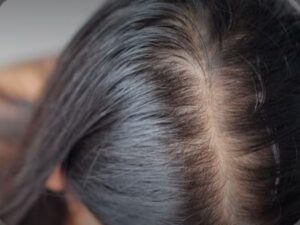
- 5.1. Don’t Wash Harder, Wash Smarter
- It makes sense to feel the need to shampoo more frequently because your scalp feels unclean. Daily hair washing, however, may have the opposite effect, depleting your scalp of its natural oils and telling your sebaceous glands to generate even more oil to make up for it.
- The better course of action?
- Use a mild, sulfate-free shampoo instead. Foaming agents called sulphates, such as SLS or SLES, are effective at cleaning, but they may be too harsh for people with oily scalps. Seek out shampoos with the labels “for oily scalp,” “balancing,” or “clarifying but gentle.” Salicylic acid, green tea, rosemary, and tea tree oil are important components that control sebum without irritating the skin.
- Depending on how oily your scalp is, cut down on frequency to every other day or even two or three times a week.
- Shampoo should be applied to the scalp rather than the hair. This keeps your ends from drying out and helps clean where it counts most.
- Bonus Tip: Rinse your scalp well, avoiding hot water as this may encourage the production of additional oil. Instead, use lukewarm or cool water.
- 5.2. Explain Once Every Week
- Not all product residue, mineral deposits, or excess oil can be eliminated by even the greatest shampoos. Weekly clarifying treatments can help with it.
- Don’t use too much clarifying shampoo, though, as it removes debris and deeply revitalises the scalp.
- Select a clarifying shampoo that isn’t overly scented or alcoholic. Only use it once a week, or every ten days if you have a sensitive scalp.
- Apply a mild conditioner solely to the ends and lengths afterward.
- Do you favour natural remedies? Try this DIY, which was suggested by a dermatologist:
- 5.3. Turn the conditioner down.
- Conditioner is essential, particularly for long or color-treated hair, however if you have oily scalp, it’s a big error to put it on your scalp.
- Conditioner should always be applied from mid-length to ends only.
- Use rinse-out, mild solutions that are labelled “for oily hair” or “volumising.” Steer clear of thick, creamy items that could leave a residue.
- Just give the conditioner a minute or two before giving it a good rinse.
- In addition to making hair feel heavy, over-conditioning at the roots can retain oil and quickly make your scalp appear oily.
- 5.4. Select Appropriate Hair Products
- Choose lightweight, water-based serums and non-comedogenic oils.
- What you use after washing can either prolong freshness or undo all of your hard work in a matter of hours if you have an oily scalp. By using pore-clogging oils, creamy leave-ins, or heavy styling products, many people unintentionally harm their scalp. The answer? better choice of products.
- Start by choosing lightweight, water-based products made especially for fine or greasy hair. These goods frequently include the following ingredients:
- Vera aloe
- Extract from green tea
- Hazel witch
- Oil of tea tree
- The panthenol or niacinamide
- These substances calm the scalp, gently control oil production, and moisturise without adding grease.
- Steer clear of oil-based serums and thick lotions close to the roots. Coconut oil and argan oil are great for dry ends, but they shouldn’t be applied to the scalp if it’s already producing too much oil. Instead, choose oils that don’t clog pores, or non-comedogenic oils, like:
- Jojoba oil, which closely resembles sebum in nature
- Squalane
- Light and high in linoleic acid, grapeseed oil
- If your scalp is already oily, avoid overnight soaks and use oil as a treatment only once a week. After giving it a light massage and letting it sit for half an hour, thoroughly wash with a mild shampoo.
- “You can definitely use oil-based products, but if you’re prone to greasiness, they need to be used sparingly and kept off the scalp,” explains celebrity hairstylist Harry Josh.
- Important tip: Read product labels at all times. Select leave-in and styling products that are:
- Not comedogenic
- Not heavy
- Free of silicone (to prevent accumulation)
- Free of alcohol (to avoid rebound oiliness from dryness)
- 5.5. Use a Dry Shampoo (Strategically)
- Avoid overusing it, but it absorbs oil in between washes.
- When used properly, dry shampoo may alter everything, but it’s simple to abuse it and wind up with more issues than you had before.
- Your hair will seem instantly fresher thanks to these powders or sprays that are made to absorb extra oil from the roots and scalp. Dry shampoo helps retain volume and appearance without water, making it perfect for hectic mornings or prolonging the time between washes.
- The catch is that using dry shampoo excessively can:
- clog the hair follicles
- cause itching or irritation of the scalp
- cause more accumulation, which eventually makes greasiness worse.
- In order to utilise it correctly:
- Don’t cover the entire scalp with it; just the roots and part lines should receive it.
- Apply a tiny bit, 6 to 8 inches from your head.
- To evenly distribute the powder, rub in and brush through after letting it sit for five to ten minutes.
- Choose dry shampoos that contain natural absorbents like rice starch, kaolin clay, or charcoal instead of talc, strong fragrances, or alcohols.
- For a do-it-yourself treatment, use a clean cosmetics brush to dust your roots with cornflour or arrowroot powder if you prefer natural alternatives.
- Above all, avoid using dry shampoo in place of regular washing. Consider it a temporary solution rather than a long-term one. Dermatologists advise using it no more than once or twice a week.
6. When to See a Dermatologist
- Perhaps It’s Not Just Grease
- It’s common to have occasional oiliness on your scalp, particularly in warmer areas, during hormone changes, or when trying out new hair products.
- But it might be time to see a dermatologist and go past DIY solutions if your oily scalp is accompanied by enduring symptoms like itching, peeling, redness, or hair thinning.
- Professional treatment is necessary for certain conditions that resemble or intensify oiliness, even if many cases of oily scalp are just the result of overactive sebaceous glands or product abuse.
- Ignoring these symptoms may exacerbate the illness or cause permanent harm to the scalp and hair.

- The following are telltale signs that your scalp might be experiencing more than simply too much oil:
- Inflammation or an itchy scalp that persists after using gentle shampoos
- Large, persistent flakes that feel greasy or oily but resemble dandruff
- Sores, pustules, or painful or red areas along the scalp line
- Hair loss or thinning, particularly in the vicinity of greasy areas
- Bad smell that persists even after frequent washing
- When touched, the scalp feels warm or painful.
- Seborrhoeic dermatitis, fungal infections, scalp psoriasis, and even hormonal problems like PCOS or androgenic alopecia may be the cause of these symptoms.
- Frequently Assumed to Be Greasy Scalp
- The following conditions can cause or mimic greasy accumulation on the scalp:
- Seborrhoeic Dermatitis: A persistent kind of eczema characterised by redness, peeling, and oily spots. Medicated shampoos and occasionally prescription treatments are necessary for this condition, which is frequently mistaken for dandruff.
- Malassezia Overgrowth: An oil-feeding yeast that grows well in greasy conditions, resulting in irritation and flakes that resemble dandruff.
- Scalp follicle: inflammation or infection, which can result in discomfort and pus-filled pimples on an oily scalp, is known as scalp folliculitis.
- Hormonal Disorders: Hair loss, irregular periods, and chronic oiliness with acne can result from PCOS and other endocrine disorders.
- Psoriasis: Although not connected to oil, psoriasis of the scalp can result in greasy-looking accumulation that is really caused by rapid skin turnover.
- The Role of a Dermatologist
- A dermatologist can examine your scalp with dermoscopy, visual inspection, or even laboratory procedures like skin swabs and hormone panels. Depending on the diagnosis, they might suggest:
- Shampoos with antifungal, antibacterial, or anti-inflammatory ingredients (such as salicylic acid, ciclopirox, or ketoconazole) that are prescribed
- Medicated foams or topical steroids
- For underlying issues, hormonal therapy or lifestyle changes
- Dietary guidelines for lowering oil triggers
- Treating the underlying cause of the oil imbalance in your scalp is more important than merely managing its symptoms.
7. Final Thoughts
- The key is balance.
- Although having an oily scalp might be annoying, uncomfortable, or even embarrassing, it’s crucial to realise that it’s not a defect. Actually, your scalp is protecting and hydrating itself—exactly what it was made to do. Finding the ideal balance between cleaning, moisturising, and honouring the natural biology of your scalp is more important for controlling oily hair than trying to remove all of the oil.
- Sebum is a natural conditioner when it is produced in sufficient quantities. It keeps the skin hydrated, shields it from the elements, and supports a balanced microbiome. It only becomes an issue when it is produced in excess or when it is coupled with hormone abnormalities, inappropriate products, or inadequate scalp hygiene. Even yet, it’s something to comprehend rather than something to be afraid of.
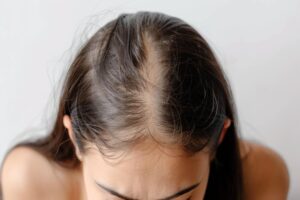
- We’ve covered the most common causes of oily scalps within a day after washing in this guide, including overwashing, using the incorrect shampoo, hormone fluctuations, unclean tools, frequent touching, and even the weather.
- Along with offering focused, doable answers, we’ve also explained the distinction between actual oiliness and product accumulation, from washing less frequently and using lighter products to clarifying once a week and strategically using dry shampoo.
- But arguably the most crucial lesson is that your scalp needs partnership, not punishment. A lot of individuals attempt to “fight” oiliness by washing more frequently, using harsh products, or vigorously cleaning.
- Paradoxically, these strategies frequently backfire, aggravating your sebaceous glands and further upsetting the natural rhythm of your scalp.
- What you actually need for your scalp is:
- Careful handling, not forceful stripping
- Regularity rather than constant change
- Choosing products wisely based on your hair type and scalp
- Pay attention to your body’s cues, particularly if you have symptoms like itching, flaking, or hair loss.
- You are not alone if you feel that you are caught in a loop of washing, oiling, and repeating. This is a common occurrence, and there is a way to move on without overcompensating or overwashing. It begins with a mental adjustment: your greasy scalp is active, not unclean.
- Give your scalp the resources it needs to perform at its best. Sometimes that entails taking a break from your daily routine and reassessing what actually suits your unique requirements.
- The restoration of scalp harmony can be achieved with a little perseverance and the appropriate methods.
- And don’t be afraid to consult a dermatologist if you’ve done everything and are still experiencing chronic pain or oiliness. Receiving professional advice can have a significant impact on scalp health, which is a component of total wellness.
Simple Faq
Simple yet effective Elementor FAQ widget.
1. Why does my scalp get oily just a day after washing?
This often happens due to overactive sebaceous glands, which produce too much sebum (natural oil). It can be triggered by overwashing, hormonal changes, using the wrong shampoo, or even the weather. The more you strip away the oil, the more your scalp tries to produce.
2. Can overwashing my hair cause it to become oilier?
Yes. Washing too frequently—especially with harsh shampoos—strips your scalp of its natural oils, prompting it to produce even more oil to compensate. This leads to a cycle of greasiness and frequent washing.
3. What kind of shampoo is best for an oily scalp?
Look for sulfate-free, lightweight, and balancing shampoos with ingredients like tea tree oil, salicylic acid, or green tea. Avoid overly moisturizing or creamy shampoos unless your ends are dry.
4. Is product buildup the same as oiliness?
No. Sebum is naturally produced by your scalp, while product buildup comes from leftover styling products, oils, or conditioners. Buildup often feels waxy or sticky, while oiliness feels slick or greasy.
5. Can stress or hormones cause my scalp to get oilier?
Absolutely. Hormonal imbalances during puberty, menstruation, pregnancy, or PCOS can increase oil production. Stress also elevates cortisol, which may stimulate the sebaceous glands.
6. How often should I wash my hair if I have an oily scalp?
Most experts recommend 2–3 times a week for oily scalps. Adjust based on your activity level and how your scalp feels. Using a dry shampoo in between can help absorb excess oil without overwashing.
7. Is it okay to use conditioner if I have oily hair?
Yes, but use it only from the mid-length to the ends. Avoid applying conditioner to your scalp, as this can weigh hair down and contribute to a greasy appearance.
8. How can I naturally reduce scalp oiliness?
Try rinsing with apple cider vinegar once a week, avoid touching your hair too often, and use products with natural astringents like witch hazel, rosemary, or tea tree oil.
9. Can using dry shampoo too often harm my scalp?
Yes. While dry shampoo helps control oil in the short term, overuse can clog hair follicles, cause irritation, and lead to more buildup. Limit use to 1–2 times a week.
10. When should I see a dermatologist for an oily scalp?
If you also experience itchiness, persistent dandruff, hair loss, redness, or sores, it could be a sign of conditions like seborrheic dermatitis, scalp psoriasis, or a fungal infection. A dermatologist can offer the right diagnosis and treatment plan.
